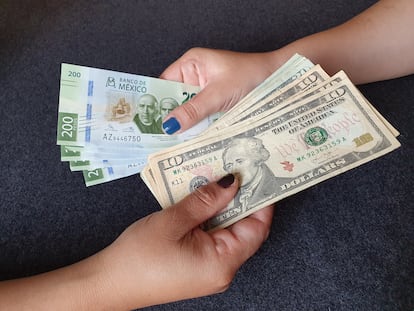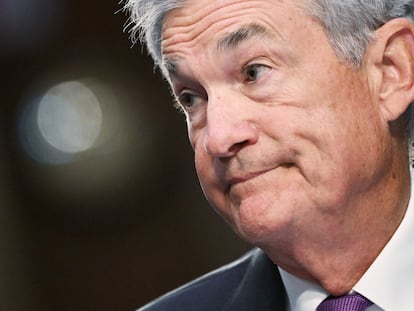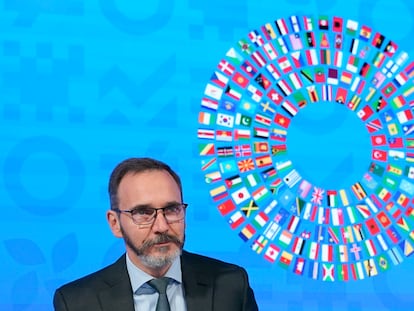The Mexican peso breaks through the 17-unit-per-dollar barrier and reaches its highest appreciation in eight years
The currency is trading at its best level since December 2015, and has kept up its momentum in recent months, partially driven by the dollar’s weakness

The Mexican peso continues its streak of appreciating in value. This Wednesday, the dollar traded below 17 pesos per unit, reaching the 16.98 level. The Mexican currency has now crossed that threshold for the first time since December 18, 2015. Remittances, foreign investment driven by the relocation of companies from Asia to North America (known as nearshoring), and the attractive yield of Mexican assets are driving the currency’s atypical appreciation. A final factor in this phenomenon is the rebound of tourism in Mexico, following the two years of the pandemic during which this sector suffered losses.
According to the Bank of America, the Mexican peso has appreciated against the dollar by almost 20% since 2022. Other emerging currencies have also appreciated in recent months, while the dollar has been weakening. This is partly due to concerns that the U.S., the world’s leading economy, could go into a recession or fall into a slowdown by the end of the year. Most developed-country currencies were showing losses on Wednesday as a result of the release of negative service sector data from China, which raised concerns about global growth.
“Capital will continue to enter Mexico because of nearshoring,” said Jesús Garza, the director of the company Soluciones Financieras Gamma and professor of economics and finance at the Monterrey Institute of Technology and Higher Education (TEC). The interest rate differential, which refers to the difference between the interest rate set by the Bank of Mexico and the one set by the Federal Reserve in the U.S., is very attractive for investors, Garza points out. In the Chair of the Fed’s latest message, the institution signaled the possibility of starting to reduce its rate next year. “The Fed will probably raise its rate twice more this year [and] start lowering it next year, but [the differential] is also going to depend on the Bank of Mexico,” Garza said by telephone.
“The nearshoring that’s increasing investment, the $60 billion in remittances that are accumulating, the fact that exports remain resilient, the interest rate differential and the rebound in tourism all” contribute to the fact that the Mexican peso is strengthening at these levels, Garza added.
However, four pillars of the Mexican economy are negatively affected by the stronger currency. Oil revenues, tourism, exports and remittances, all denominated in dollars, are squeezing the government’s finances as well as those of Mexican families. This may even have been a factor in why relatives abroad sent more money to Mexico in April and May, said Luis Gonzali, a mathematician and financial strategist at Franklin Templeton in Mexico City.
“At the end of the day, this appreciation of the peso doesn’t help the people who receive remittances,” Gonzali said. Mexicans “in the U.S. have to send more dollars to their relatives here in Mexico so they don’t lose purchasing power. Sending $1,000 when the dollar is at 20 pesos is different from sending $1,000 when it is at 17 pesos.”
According to Gonzali, despite the fact that the Bank of Mexico was ahead of the cycle of interest rate hikes worldwide, the rate differential is not a significant factor in the currency’s recent appreciation because foreign investment in Mexican bonds is at its lowest level in 13 years. “At the moment, this is an issue that isn’t very important, because we are seeing foreigners get out of local debt,” the specialist said.
Sign up for our weekly newsletter to get more English-language news coverage from EL PAÍS USA Edition
Tu suscripción se está usando en otro dispositivo
¿Quieres añadir otro usuario a tu suscripción?
Si continúas leyendo en este dispositivo, no se podrá leer en el otro.
FlechaTu suscripción se está usando en otro dispositivo y solo puedes acceder a EL PAÍS desde un dispositivo a la vez.
Si quieres compartir tu cuenta, cambia tu suscripción a la modalidad Premium, así podrás añadir otro usuario. Cada uno accederá con su propia cuenta de email, lo que os permitirá personalizar vuestra experiencia en EL PAÍS.
¿Tienes una suscripción de empresa? Accede aquí para contratar más cuentas.
En el caso de no saber quién está usando tu cuenta, te recomendamos cambiar tu contraseña aquí.
Si decides continuar compartiendo tu cuenta, este mensaje se mostrará en tu dispositivo y en el de la otra persona que está usando tu cuenta de forma indefinida, afectando a tu experiencia de lectura. Puedes consultar aquí los términos y condiciones de la suscripción digital.
More information
Últimas noticias
Most viewed
- Sinaloa Cartel war is taking its toll on Los Chapitos
- Oona Chaplin: ‘I told James Cameron that I was living in a treehouse and starting a permaculture project with a friend’
- Reinhard Genzel, Nobel laureate in physics: ‘One-minute videos will never give you the truth’
- Why the price of coffee has skyrocketed: from Brazilian plantations to specialty coffee houses
- Silver prices are going crazy: This is what’s fueling the rally











































